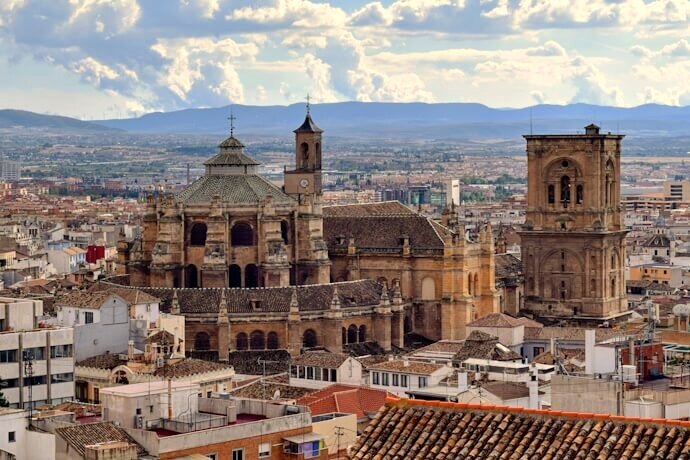Nestled within the vibrant tapestry of Spain’s architectural landscape lies a treasure trove of religious monumental wonders that embody the Kingdom’s devout Catholicism in the form of majestic cathedrals. Faith and history seamlessly intertwine with the cities’ skyline, resulting in one-of-a-kind landscapes embellished by captivating edifices that have shaped trends and movements.
From the intricate curves of Moorish design to the daring grandeur of the Renaissance, each of the following religious monuments have played a pivotal role in Spain’s identity construction and outlook as a southern European gem. Join us as we uncover the country’s top eight most beautiful cathedrals you must include in your trip itinerary!
1. Santiago de Compostela Cathedral
The endpoint of the popular Way of St. James pilgrimage is an outstanding cathedral known worldwide for its religious and architectural importance. Located in the city of Santiago de Compostela, this monument embodies the Christian Reconquest of Spain. For its importance, the area in which the cathedral was established is recognised as a UNESCO World Heritage Site.
Observing the Romanesque structure of the Cathedral of Santiago de Compostela’s façade, you are compelled to enter its sacred interior. Before stepping inside, a portico with over 200 granite sculptures evokes the weight of faith in this religious site where the supposed tomb of Saint James lies. Even if you are not a Catholic, the interior blend of architectural styles promise to move you with its undeniable beauty.
From this monument, the city unfolds before your eyes as an eclectic location made of vibrant squares, picturesque cobblestoned streets and dazzling oases of spirituality. Plaza del Obradoiro can be your starting point for an exciting day exploring Santiago!
2. Granada Cathedral
Also known as the Cathedral of the Incarnation, the Granada Cathedral is a captivating Gothic and Renaissance edifice that dates back to the 16th century, in the aftermath of the city’s transition from the Moorish rule to the Spanish Crown led by King Ferdinand V. Diego de Siloé is the name behind the construction of this UNESCO World Heritage Site.
As you approach Granada Cathedral’s interior, the sight of ornate sculptures illuminated by the play of colourful light shining through the stained-glass windows, you are immediately transported to the whispering stories concealed in each stone. The scattered paintings of Alonso Cano add a layer of artistic spirituality to an already mesmerising barrier-breaking Baroque style and Renaissance grace.
Out in the town, the cathedral emerges from the skyline as an architectural marvel waiting to be explored and admired. Surely, this religious hub introduces itself as a symbol of the city’s rich history and cultural identity of Moorish influences and Catholic lines.
3. Zaragoza’s Basilica del Pilar
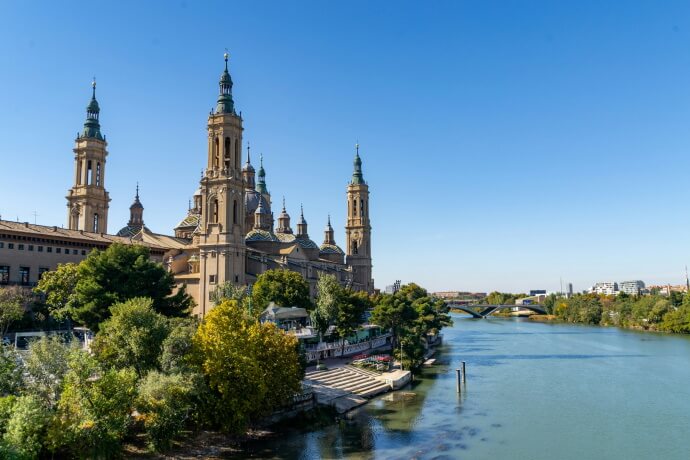
The ethereal allure of Zaragoza’s Basilica del Pilar transcends time and space, promoting a sensorial experience through the sacred realms of spirituality. Built between the 1600s and the 1700s, this jewel of Baroque art epitomises the Spanish take on this revolutionary architectural movement. The kaleidoscope tile-adorned domes mingling with the gentle chatter of the streets create an outright magnetic ambience.
Within the hallowed halls of this construction lies a collection of A-grade art and valuable objects from different historical periods. Amongst this display, the frescoes painted by Goya in the choir charm the onlooker with its ingenious master of creative art.
Standing as an important national monument, just like Santiago the Compostela’s Cathedral, the Basilica del Pilar welcomes pilgrims and visitors from around the world to immerse in its rich tapestry of history and faith but also its unique identity as the capital of the Aragon region.
4. El Escorial
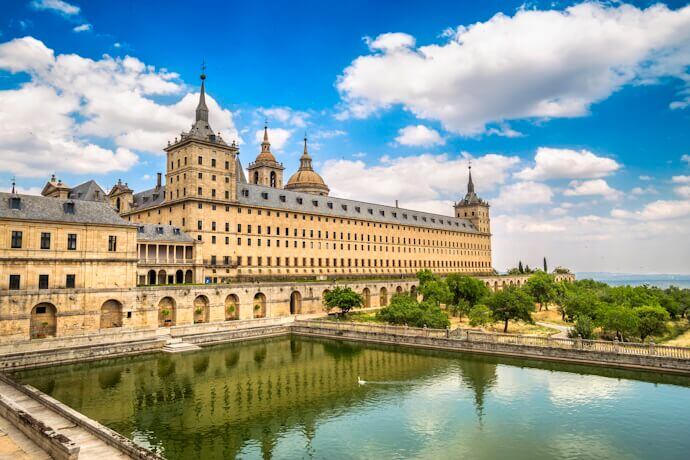
Green landscapes and remarkable monasteries mark El Escorial, a lush countryside destination sitting outside Madrid. Easily accessible from Spain’s capital by car or public transportation, this location developed under the patronage of King Philip II in the 1500s and is a poignant reflection of the kingdom’s catholic devotion allied to political prominence.
El Escorial holds the reputation of a palace, monastery and mausoleum defined by simple lines where the harmoniously designed courtyards, fountains, cloisters and tower pop colour and shape to an overall minimalistic design. The Basilica itself, accessible through the Courtyard of the Kings of Judea, is both a sacred space and an art gallery marked by a 95-metre dome and Lucas Jordán paintings.
Ultimately, the architectural splendour of El Escorial with its vast corridors, ornate chapels and landscaped gardens reminds you of the zenith of the Spanish monarchy and its inalienability from Catholicism as a vessel through which to legitimise and enlarge power.
5. Salamanca Cathedral

Nestled in the heart of this historical city, Salamanca Cathedral introduces itself as an architectural jewel with a peculiar, nonetheless, structure. Two churches, one from the 12th and 13th centuries, and a newer one from the 1500s, were joined to form what is now Salamanca’s Cathedral.
The older structure was built in the Romanesque style, marked by a more sober aesthetic and an outstanding Gallo Tower. Inside this medieval gem, you will find the famous San Martín, otherwise known as the Oil Chapel. On the other hand, the newer cathedral includes elements of the late Gothic, Renaissance and Baroque elements that culminate in an imposing façade adorned with intricate carvings and elaborate sculptures.
As a UNESCO World Heritage Site, this religious space plays a central role in the city’s allure as a touristic destination. Therefore, the cathedral acts as a focal point for locals and visitors who want to immerse themselves in the history and culture of Salamanca. To this day, this monument is a hub for religious ceremonies, cultural events and academic gatherings!
6. Santa Iglesia Cathedral of Seville
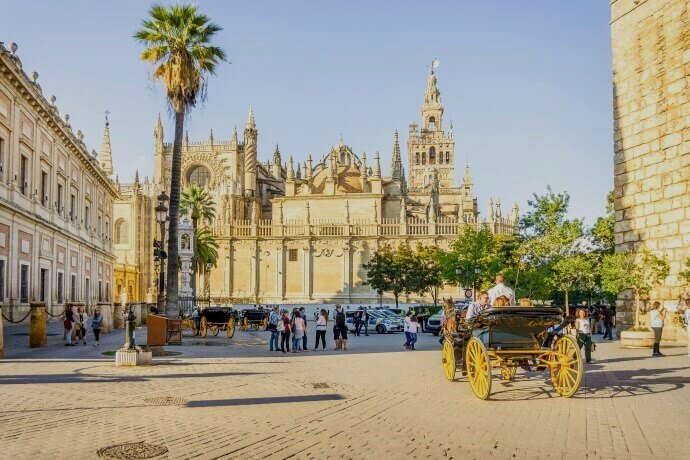
The former site of Seville’s Aljama Mosque is now the home to one of the largest Gothic Cathedrals in the world. Located in a lively Andalusian city, this religious monument is a physical representation of the triumph of Christianity in the south of Spain – one of the last places conquered from the Moors.
Despite the connection to Catholicism, this monument has maintained its original structure, which includes the charming Patio de los Naranjos and the La Giralda, an iconic bell tower. Climbing up to the top, your eyes are graced with privileged views of Seville and its enrapturing landscape. The contrasting lush green of the courtyard and the orange hues of the town’s buildings will fill your soul with the spiritual, but most of all, architectural magic of Spain.
Inside, the aesthetic is one of pure spirituality, heightened by the enthralling stained-glass windows and gold adornments that make way to the tomb of Christopher Columbus, a marking figure in the Age of the Discoveries, and the royal chapel.
7. Burgos Cathedral
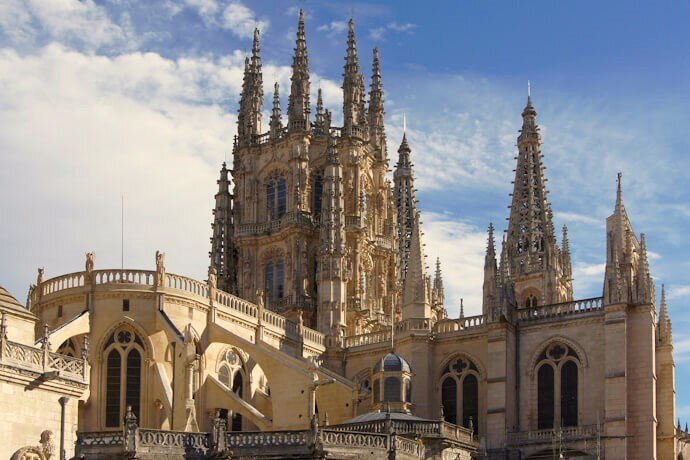
Puerta del Perdón is the imposing face of Burgos’ Cathedral, a remarkable religious construction recognised by UNESCO that dominates the skyline of a vibrant city concealed in the Castille y León region.
Gazing upon its awe-inspiring altars and Gothic-style stained-glass windows, you are instantly connected to the destination’s rich history and culture. The monument has been, since its inception, a focal point in town for gatherings of the community. In this way, the civic pride inspired by Burgos Cathedral becomes immediately apparent once one stands within the walls of this marvellous creation.
Between the starred rose window, the statue-adorned gallery with representations of the monarchs of Castille and 15th-century spires, you will surely be left in awe by the dome with a Mudejar vault, where right beneath lie the remains of Rodrigo Díaz de Vivar, also known as “El Cid Campeador”, a noble warrior.
8. Córdoba
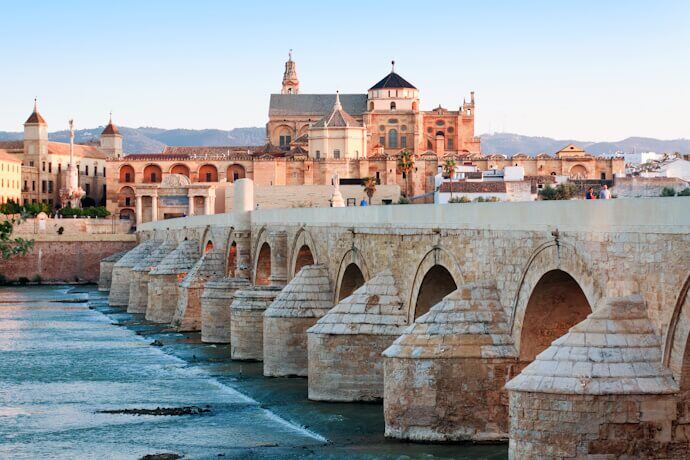
Over the course of more than 200 years, Córdoba’s Cathedral has shaped the town’s culture and identity as a versatile house of worship that has taken the shape of a Visigoth Basilica, a Muslim Mosque and a Catholic Cathedral later in the aftermath of the reconquest.
With all of these transformations, this monument has become an eclectic representation of faith with well-preserved elements from the different cultures that once inhabited its storied halls. The lofty pillars topped by red and white fringed arches are the first features that strike your attention as you stand before it. Inside, the expansive prayer hall, with hundreds of horseshoe arches embellished by geometric patterns, pays homage to its Islamic roots. The Christian chapels and altars, on the other hand, reflect the cathedral’s Christian identity.
The duality of this majestic cathedral is symbolic of Cordoba’s ability to incorporate into its identity the embrace and celebration of its multicultural past that expands into other landmarks, such as the Jewish neighbourhood and the Synagogue.
A religious adventure across Spain
As we embarked on a fascinating religious voyage across Spain, we witnessed the spectacular vistas in the Aragón region, traversed across the reconquered Moorish lands of Andalusia and glimpsed the Royal patronage in El Escorial. Each architectural masterpiece is an invitation to delve into this country’s faith and culture. In the end, from Santiago de Compostela’s grandeur to Córdoba’s multiculturality, there is an excitingly beautiful religious construction waiting for your curious eyes. So, pack your bags and venture into a new perspective of Spain, one led by its faith!



